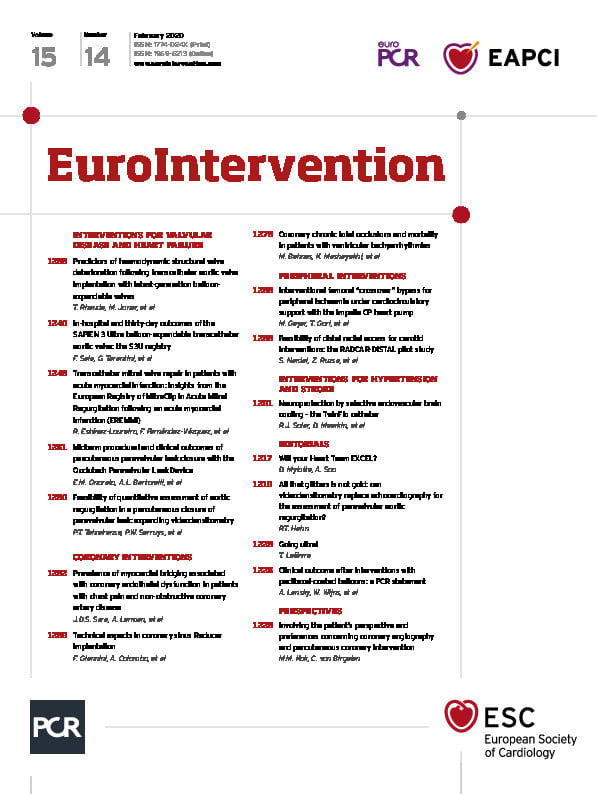
Based on the Gregorian calendar, 2020 is a leap year, as all years which are multiples of four but are not centennials not divisible by 400 (yes, I double checked). As you know, the extra day (29 February) is intended to keep the calendar year synchronised with the astronomical or seasonal year. Thus, this month we have one more day to do what we do every day or, for those of us who can, take a break and dedicate ourselves to our favourite activities … including reading EuroIntervention. Here’s a glance at what we have in store for you in this issue of the Journal.
The long-term durability of transcatheter aortic valve implantation (TAVI) is a matter of growing interest, and several reports have been published using standardised definitions of haemodynamic structural valve deterioration (SVD) and bioprosthetic valve failure1. Tobias Rheude, Michael Joner and colleagues go one step further and now report on the predictors of moderate or greater haemodynamic SVD after TAVI, using a data set of 691 patients with follow-up at 12 months2. Their laudable attempt to characterise SVD provides useful insights into the underlying mechanisms of this phenomenon, with potential clinical implications since procedural factors and pharmacotherapy played a major role. TAVI is a moving target: while we are more and more interested in long-term outcomes from the pivotal studies, valve technologies evolve and studies of early outcomes remain key to capture improvements, if any, in the rate of acute complications, such as access-site complications, stroke and permanent pacemaker implantation. Francesco Saia, Giuseppe Tarantini and colleagues report the in-hospital and 30-day results of the prospective, multicentre, international S3U registry of the latest iteration of the SAPIEN 3 balloon-expandable valve, named “Ultra”3. The report includes data on 139 patients undergoing transfemoral TAVI at nine participating centres, with a mean age of 81 years and a mean STS score of 3.8 points. I leave to the readers’ interest and curiosity the opportunity to appraise the in-hospital and 30-day outcomes of this device in a contemporary TAVI population. Two more articles elaborate on the issue of paravalvular leak closure. In the first article, Eustaquio Maria Onorato, Antonio Bartorelli and colleagues report the results of a registry (n=136) of the Occlutech device, representing the collective experience of 21 sites in nine countries4. In the second article, a cardiovascular flashlight from Pablo Teixeirense, Patrick Serruys and colleagues provides new insights on videodensitometry as a tool for quantitative assessment of paravalvular leakage through a surgically implanted aortic valve, prior to and after percutaneous closure of the tunnel with a plug5. The case nicely illustrates the emerging use of videodensitometry as a quantitative tool in aortic valve interventions other than TAVI. A further area of increasing interest is the use of transcatheter mitral valve repair with the MitraClip procedure in the setting of acute myocardial infarction, where acute ischaemic mitral regurgitation may develop due to leaflet tethering. Rodrigo Estévez-Loureiro, Felipe Fernández-Vázquez and colleagues report on the six-month results of the EREMMI (European Registry of MitraClip in Acute Mitral Regurgitation Following an Acute Myocardial Infarction) registry, the largest (yet, only 44 patients at present) data collection on this topic so far, recently presented at PCR London Valves6.
Let us now consider the articles on interventions for coronary and cerebrovascular artery disease. Myocardial bridging is of relatively frequent observation in daily cath lab routine and may be associated with angina and acute coronary syndromes. A paper from Jaskanwal Deep Singh Sara, Amir Lerman and colleagues characterises the degree of endothelial dysfunction associated with myocardial bridging, suggesting a role for therapies targeted at addressing microvascular dysfunction for patients with this condition7. In another study, using data from a registry of patients with ventricular arrhythmias (N=1,461), Michael Behnes, Kambis Mashayekhi and colleagues explore the independent prognostic role of chronic total occlusions on mortality at 18 months8. After adjusting for potential confounders, they found a significant 1.5-fold association, which I’m convinced will set the basis for further investigations on this topic. Also in this issue, an expert and richly illustrated review from Francesco Giannini, Antonio Colombo and colleagues summarises the technical aspects of coronary sinus narrowing for refractory angina by implantation of a balloon-expandable, hourglass-shaped, stainless steel mesh9 – a reference paper for those who are dealing with or want to deal with this procedure. Finally, a stimulating letter exchange returns to the topic of long-term outcomes of coronary covered stents10,11, which Harnek and colleagues covered in a previous issue, reporting from the SCAAR experience12.
In the section on interventions for peripheral artery disease, I believe the readers will enjoy the cardiovascular flashlight from Martin Geyer, Tommaso Gori and colleagues, illustrating a “self-made” femoral crossover bypass for peripheral ischaemia under cardiocirculatory support by an axial flow pump13. The increasing success of distal radial access for percutaneous coronary intervention expands to the domain of carotid intervention with the pilot RADCAR-DISTAL study from Sandor Nardai, Zoltán Ruzsa and colleagues14. This issue also features an interesting report on innovation in the field of interventions for brain protection. Ronald Jay Solar, David Meerkin and colleagues describe the experimental in vivo studies and initial clinical experience with the new TwinFlo catheter, designed to provide rapid deep hypothermia15.
We hope you will enjoy this issue and take home insights that are useful to your practice. Please do not hesitate to let us know your opinion and your suggestions, and reactions to what you read here, on the website or through social media. Best wishes to those born on 29 February and we look forward to seeing you again in March.
Supplementary data
To read the full content of this article, please download the PDF.

